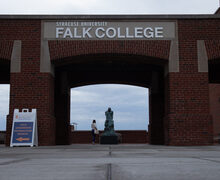SU Spanish department, campus organizations work to spread Latino culture
Courtesy of Gail Bulman
The Spanish Language, Literature and Culture department has continued to teach classes despite the obstacles of the COVID-19 pandemic
The Daily Orange is a nonprofit newsroom that receives no funding from Syracuse University. Consider donating today to support our mission.
The Spanish Language, Literature and Culture department at Syracuse University has continued to provide classes that maintain students’ interest in Latino heritage and culture, despite obstacles due to the coronavirus pandemic.
Through class activities and partnerships with La Casita Cultural Center and the Program on Latin American and the Caribbean (PLACA), the department engages students in Latino culture.
The department is actively looking for a professor to teach about Latino literature, media and culture. Gail Bulman, an associate professor of Spanish and the director of PLACA, said that the department had a full-time tenure track professor of Latino studies, literature and culture, but the staff member left the university.

The Spanish Language, Literature and Culture department offers academic courses that reflect interest in the Latino community. Courtesy of Gail Bulman
After that, Bulman said that they were able to hire another professor for the past year and a half, but they weren’t able to renew his contract due to COVID-19 complications.
For now, the Spanish department offers academic courses that reflect interest in the Latino community.
One of the courses the department offers is a linguistic course called “Community Outreach: Language in Action,” in which students go out and do projects with members of the community around language usage.
Bulman explained that some students have done research projects after taking this course. Projects in the past have included looking at dialect, variation and change, phonetics, difference in word choices and pronunciations in Caribbean, South American, and Mexican communities, she said.
Elizabeth Juarez-Cummings, an assistant teaching professor, is the Spanish Language Coordinator for the introductory courses Spanish 101 and 102, which concentrate on grammar and structure. But Juarez-Cummings said these courses have a requirement for students to explore Latino culture.
The requirement includes activities that engage students in a cultural component, such as researching current events in Latin America. In these current event activities, students find what they like and explore any news that relates to their preferred topic in Spanish-speaking countries.
Juarez-Cummings wants students to pursue the topics that they’re interested in and connect it to Spanish speaking countries, no matter how random the topics may be.
“When I did a search on Batman, there was a convention in Mexico City about Batman and the Batiseñal or Bat-Signal projected in one of the biggest buildings in Mexico City,” Juarez-Cummings said. “It is funny, right, but it gives the students an idea on how they can connect their interest with the Spanish-speaking world.”
Students in Spanish 101 and 102 also complete reflection papers at the end of the semester. These reflection papers ask several questions related to the student’s experience with the language and are geared to help them understand the relevancy of learning Spanish in their future, Juarez-Cummings said.
Additionally, students have to research the number of Hispanic and Latino individuals in their community and do a reflection on the language presence in their community. The reflections also have to include three ways that Spanish has impacted their life. The second part of these reflection papers focuses on acknowledging the benefits of being bilingual, including professional benefits and better understanding of the presence of Hispanic and Latino people in the United States.
“We have gotten interesting essays that are really enriching for us and the students,” Juarez-Cummings said. CNY Latino, a media publication based in Syracuse, even published a couple of the reflections in 2017.
The Spanish department also strongly collaborates with La Casita Cultural Center and PLACA.

Las Naranjas also contribute to promoting Latino heritage through activities such as El Día de los Muertos. Courtesy of Gail Bulman
This semester Professor Bulman is teaching a new course called Latin American Performance Today which is based on live theater from Argentina, Peru, Mexico and the Caribbean.
“We look at different performance artists, stage performances and street theater,” she said. “We examine how these come forward both artistically but also in some ways they are very activist theater and the artists care a lot about social justice, diversity and equity and that is reflected in the aesthetics that they choose to use.”
In addition to the efforts made by the Spanish department, student organizations such as Las Naranjas also contribute to promoting Latino heritage through activities such as El Día de los Muertos. Last year, Las Naranjas handed out free churros in the atrium of Huntington Beard Crouse Hall to students who followed the Las Naranjas Instagram account.
This semester they are adjusting to a different setting because of COVID-19.
“We are still going to make the best of it by having meetings every two weeks to discuss current events, history, culture, music, art in Latin America,” Las Naranjas president Samantha Branshaw explained. “We are hoping one of the Spanish department professors will do a virtual cooking class with us this semester.”
Published on September 27, 2020 at 10:48 pm






